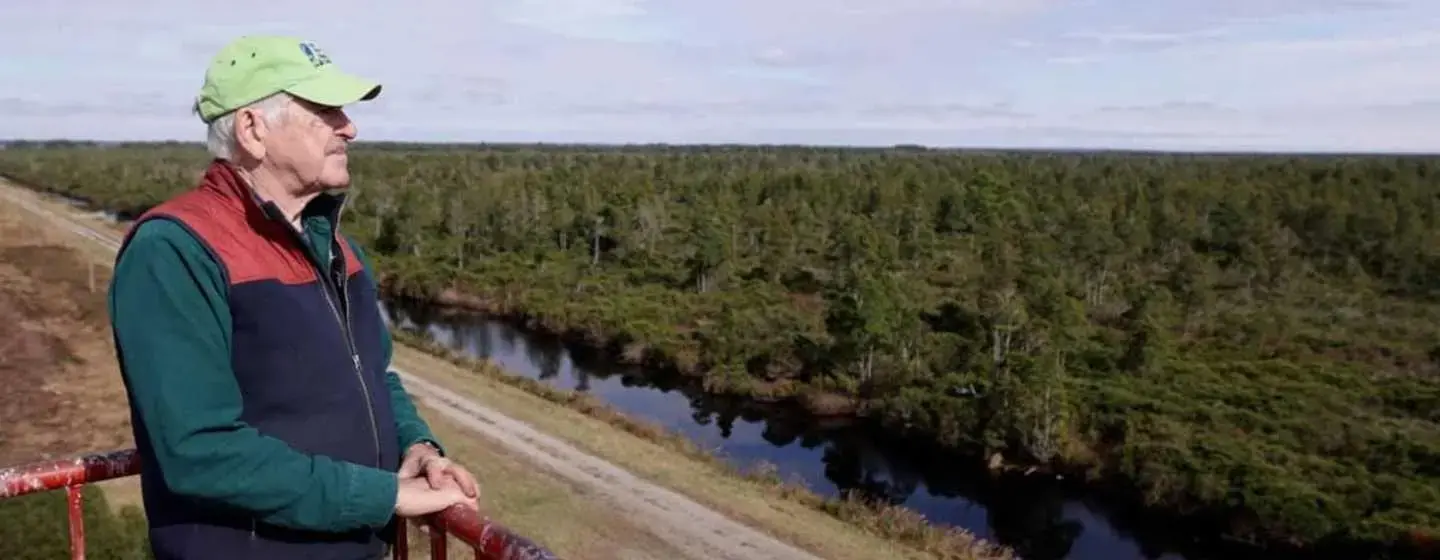
Peatlands on the North Carolina coast store centuries of carbon.
“Oh that’s good, that’s encouraging,” Neal Flanagan says as he pushes a metal tube down into the spongy ground. We’re in the Pocosin Lakes National Wildlife Refuge, and Neal is trying to take a core sample of the multiple feet of peat we’re standing on. He’s part of a team of researchers from the Duke University Wetland Center (DUWC) who have been studying this site for more than 10 years.
“Lift with the knees,” he recites as he pulls the tube back out of the ground, then rotates a metal paddle to reveal a cylinder of dark brown, moist dirt crisscrossed with pieces of leaves and twigs.
“That’s a good one,” he says as Curtis Richardson, Director of DUWC, comes over to take a look.
“That’s a beautiful core,” Curtis agrees. “That core probably represents at the base probably about 2,000 to 3,000 years in age.”

As a nonprofit journalism organization, we depend on your support to fund our nationwide Connected Coastlines climate reporting. Donate any amount today to become a Pulitzer Center Champion and receive exclusive benefits!

What Is Peat?
The core Neal pulls up contains peat, which is best described as partially decayed plant material. The plants and shrubs that grow in this area are not very palatable to microbes and are very difficult to break down, especially since microbes are deprived of oxygen in the waterlogged soil. So when they drop leaves and other plant matter, it doesn’t decay very quickly.
For the microbes, “It’s the difference between having a candy bar and a piece of wood,” explains Curtis.
This means that compared to typical forest soil, which is only around 2% organic matter, peat is around 80–90% organic matter, which makes it really good at storing carbon.
“People don’t realize there’s more carbon stored in the peatlands of the world than there are all the forests,” Curtis says.
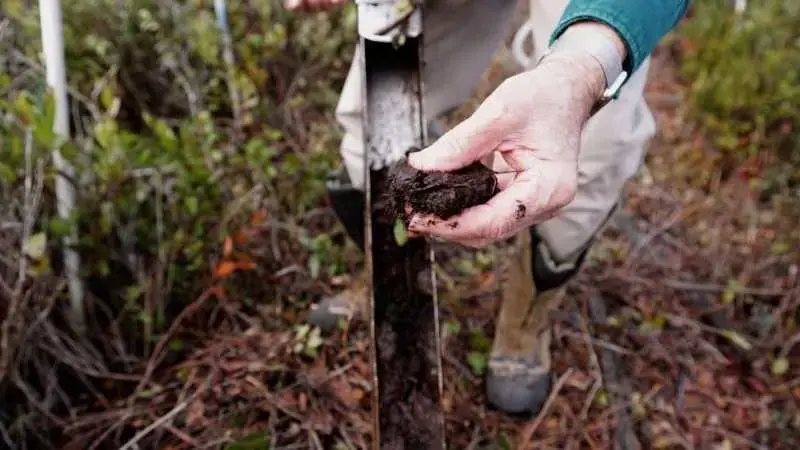
Peatlands exist all around the globe (check out the UN’s latest Global Peatlands Assessment Report). However, the unique peatland ecosystems that extend from Virginia to North Florida (but are most common on the North Carolina coast) are called pocosins because that’s what the Indigenous Algonquins called them.
Peaty Potential
In its most common gaseous state, carbon is carbon dioxide, one of the greenhouse gases that are present in our atmosphere. These gases are responsible for keeping the earth “livable” as they trap heat in a sphere around our planet. But as industrial processes pump excessive amounts of carbon dioxide and other greenhouse gases into the atmosphere, this “blanket” of gas around the planet is getting too heavy and changing our climate.
To stop or slow this change in climate, we need to both reduce the volume of greenhouse gases going into the atmosphere and increase the amount that is being pulled out of the atmosphere and stored or sequestered. According to researchers like Curtis (and the UN report), peatlands play a major role in this worldwide.
“We did these studies over a period of ten years, and it’s an amazing amount of carbon that we can store in these systems,” he says. “If you let these areas lie fallow and decompose, it can equal up to 2.5% of our annual goal of reducing carbon emissions for the entire United States. That’s an enormous amount.”
Curtis continues to explain that if 25% of the drained peatlands in Virginia, North Carolina, South Carolina and Georgia caught on fire, the emissions from that burn could equal 18% of the annual U.S. goal of atmospheric carbon dioxide reduction.
“So we’re trying to keep as much carbon in the system as we can,” he says.
Sara Ward with the U.S. Fish and Wildlife Service agrees that peatlands are essential to meeting carbon dioxide reduction goals. “If we don’t manage these lands the right way, we’ll never get it back because of how slowly they formed over time. We really have to steward them right. All of our work that we’re trying to do internationally to address climate, there’s no way we get there without our peatlands functioning.”
Altered Lands
In the ’60s and ’70s, around a third of the area now known as the Pocosin Lakes National Wildlife Refuge was drained, primarily with the hopes of creating agricultural land. A grid of ditches was carved into the pocosin peatlands to drain them, and it worked—the water seeped into the ditches and out of the land. But the peat in this area was too difficult to farm, and an additional effort to harvest the peat and burn it for energy also failed.
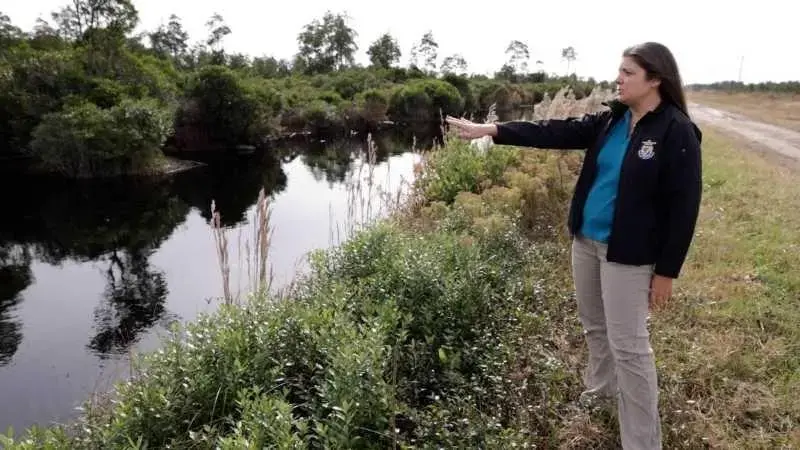
The ditches did significant damage though, drying out the highly organic—and highly flammable—peat soil.
“Most people think of forest fires and wildfire starting in the canopy or the above ground layer,” Sara points out. “But peatlands, the soil itself is combustible.”
The Evans Road Wildfire in 2008 was started by a lightning strike and burned more than 40,000 acres with smoke reaching as far as Raleigh, 150 miles west. The financial cost of the fire came in close to $20 million, but a cost more difficult to recover was the carbon previously stored in the soil that was combusted and released into the atmosphere.
“We burnt off 9.9 tera grams of carbon. That’s the amount of carbon dioxide released by 2.5 million cars driving 12,000 miles in a year, in one fire,” Curtis explains.
Because of the unique nature of peat, the soil itself is combustible, not just the plants on the surface.
“The fire will move underground,” Sara says. “And we’ve seen repeated fires out here that will burn away feet of soil, 4 to 5 feet in the most intensely burned areas.”
“A thousand years of accumulation could go up in smoke in literally an hour,” Curtis illustrates, pointing at the core of peat that Neal had pulled. “If it’s drained.”
Rewetting the Land
The key to protecting these peatlands seems to be restoring the natural hydrology, or flow of water, in previously drained pocosins.
In partnership with the U.S. Fish and Wildlife Service, the Nature Conservancy is using the ditches that initially drained the ecosystem to restore it.
Eric Soderholm, Wetland Restoration Specialist with the Nature Conservancy, drove us along one of the ditches cutting through the refuge to a metal structure in a “corner” where two ditches came together.
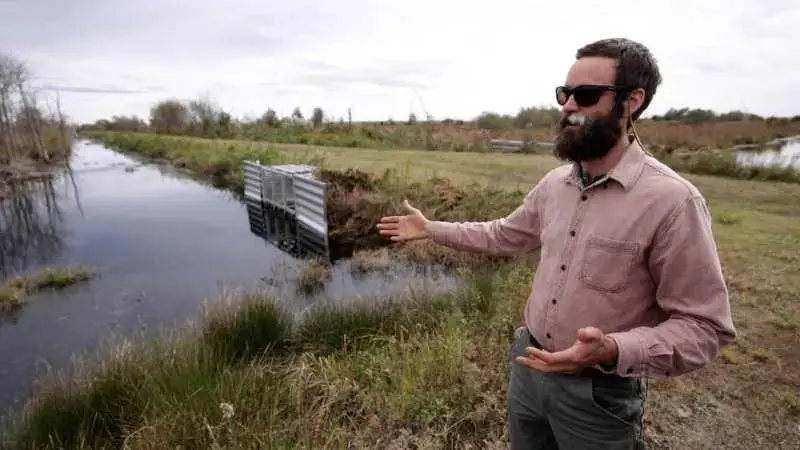
Eric illustrates how the “flash board risers” in these water-control structures between the “blocks” of the refuge created by the ditches allow restoration specialists to control the movement of water across the land.
“The refuge management staff can put wooden boards down into those weirs up to the height that they would like the water to be ideally, before it would spill over the boards and continue down,” Eric explains.
The domed nature of the pocosin wetlands allows for this water flow management.
“So we’re gradually stepping the groundwater level back up this pocosin dome. We’re rewetting with rainwater.”
Next Steps
To Eric, the most important next steps are continuing this restoration work on private lands that have been drained and were previously wetlands.
“If a private landowner were to own an area that was previously ditched and drained pocosin wetland, they could use the same sort of infrastructure that is being used at project sites all across the coastal plain here in North Carolina, re-wet their lands and then generate carbon credits that could be sold on the voluntary carbon market,” he shares.
Because the Nature Conservancy and researchers like Curtis and his team have been measuring and documenting the effects of restoring pocosins on carbon storage and the capacity healthy pocosins have to sequester carbon, the carbon offset generated by restoring an area of pocosin wetland can be quantified.
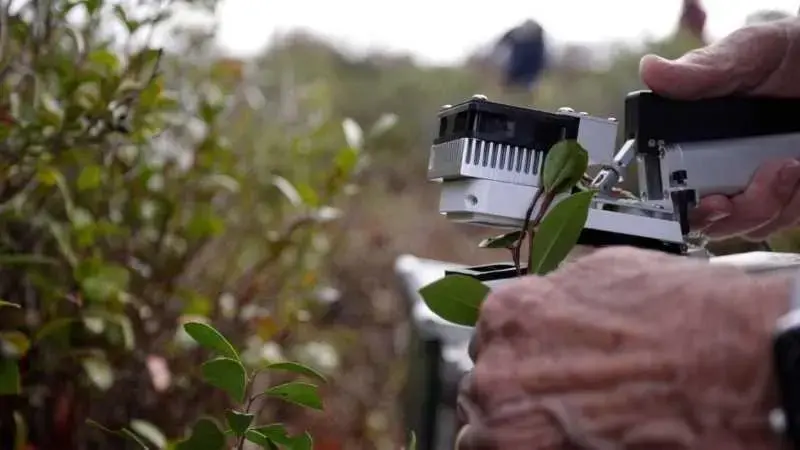
“Measuring it is important because you want to make sure that it’s truly carbon that otherwise wouldn’t have been sequestered or stored in the land,” Sara points out. “So these measurement methodologies and approaches are just a way for anyone who invests in that market to know that it was carbon that actually is moving the needle to address the problem of greenhouse gas emissions in a meaningful way.”
In March of this year (2023), a $27.5 million federal grant was announced to address climate resiliency in the Albemarle-Pamlico watershed. In an interview with WFAE-FM, Rebekah Martin, a project leader with the U.S. Fish & Wildlife Service’s Coastal North Carolina National Wildlife Refuge Complex in Manteo, says the funding is “intended to address climate threats” and the strategies they’re looking at are “focused on nature-based solutions.” In a recent email, Sara let us know that this includes expanding peatland re-wetting efforts on national wildlife refuges and state game lands in eastern North Carolina.
Which is important, because in the same month that this funding was announced, another wildfire was actively burning in the peat at Pocosin Lakes Wildlife Refuge. The Last Resort fire started off-refuge from someone burning yard waste on private land. According to InciWeb, as of April 9, 2023, it had spread to around 5,280 acres and was at 80% containment.
The Pocosin peatlands of North Carolina’s coast can store a huge amount of carbon in their spongey, highly organic soils. But when peatlands are ditched and drained, that carbon storage potential is lost and they’re vulnerable to fire. Learn how returning water to these ecosystems could have a huge impact on the amount of carbon dioxide in our atmosphere.











